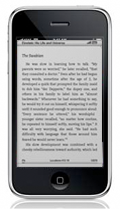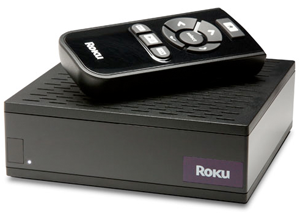 I want a million followers!
I want a million followers!
Pirate Bay: Guilty! Guilty! Guilty!
Annoy Amazon, lose Kindle books.
Report: Best Buy plans downloads.
Voting on Facebook policies begins.
Slim new Sidekick does Twitter.
 I want a million followers!
I want a million followers!
Pirate Bay: Guilty! Guilty! Guilty!
Annoy Amazon, lose Kindle books.
Report: Best Buy plans downloads.
Voting on Facebook policies begins.
Slim new Sidekick does Twitter.
 My taxes? Filed. Whew! You?
My taxes? Filed. Whew! You?
eBay: we’re spinning off Skype.
Net neutrality? Now now, please!
Amazon.com: a third of e-commerce.
AT&T wants more iPhone exclusivity.
Microsoft patches up Office holes.
 Hey, it’s Monday the thirteenth!
Hey, it’s Monday the thirteenth!
Meet Twitter-annoying teen Mikeyy.
Prince’s $2100 purple iPod Touch.
Amazon: hiding gay-themed books?
Skype should sell to founders.
Palm readying inductive-charging accessories?
Two potential Pre shipping dates.
![]() Amazon has been dipping its toes in a few new video game ventures lately. The latest from the online retailer, in addition to trading used games and offering downloadable computer games, is the sale of Xbox Live Arcade downloads.
Amazon has been dipping its toes in a few new video game ventures lately. The latest from the online retailer, in addition to trading used games and offering downloadable computer games, is the sale of Xbox Live Arcade downloads.
The new service allows customers to purchase a download code for games like Braid and Marble Blast Ultra, which is then redeemed on the Xbox 360 console. Visitors can also purchase games as gifts and send the codes to their friends.
Cool stuff, but why buy this way instead of on the console itself? Simple: Microsoft has a silly download policy that doesn’t let you pay exact change. Packages start at 500 “Microsoft Points,” equal to $6.25, and since most games come in $5 or $10 increments, buying a game through the Xbox 360 sticks you with unused points. This is supposed to encourage future downloads, I imagine, but it strikes me as underhanded. What other retailer requires you to pay extra for a product in exchange for store credit?
All online game stores do this, but to a lesser extent. The Wii Shop Channel requires purchases in $10 increments, but some games actually cost that amount (more often than not, you’re stuck with extra, though). The Playstation Network lets you pay exact change, but only for purchases greater than $5. Sony’s plan is the most justifiable, in the same way that some store owners require minimum credit card purchases to cover the transaction fee.
Kotaku has a rumor that Amazon will duplicate the service for the Wii and Playstation 3, but the retailer won’t comment. Customers should be able to pay the exact amount for their downloadable games, but it’s too bad they’ll have to jump through Amazon’s hoops to do so.
 The fracas between the Authors’s Guild and Amazon over the Kindle 2 e-book reader’s text-to-speech feature has prompted advocates for the blind and reading-disabled to remind the guild that blind people use technology too.
The fracas between the Authors’s Guild and Amazon over the Kindle 2 e-book reader’s text-to-speech feature has prompted advocates for the blind and reading-disabled to remind the guild that blind people use technology too.
In a protest outside of the guild’s Manhattan office today, demonstrators urged the guild to cease its campaign to remove text-to-speech from the Kindle. The guild maintains that it goes beyond the publishing rights that Amazon has acquired, and could impact audio book sales.
Amazon has yielded to the guild’s demands, and is permitting the feature to be turned off on a per-title basis. To its credit, the guild has worked out an agreement for the voice feature to always be an option for people with disabilities.
“Authors want everyone to read their books. We’ve been strongly supportive of the rights of the blind and disabled to obtain books…We know how to balance the interests, to make sure there is special access to books for people who need it but still protect markets that authors depend on. Audio-books is one of those markets,” Paul Aiken, executive director of the Authors Guild, told News.com.
My feeling is that text-to-speech should be broadly available as part of an accessibility pack. While I take Mr. Aiken at his word, today’s protest served to remind the guild that it has an obligation to the blind that transcends its sales and the exercise of its intellectual property rights.
 What I’m reading this morning:
What I’m reading this morning:
Twitter-like makeover for Facebook.
Ballmer: Windows Mobile needs work.
Amazon’s selling used video games.
Pogue slams Samsung’s Memoir phone.
Facebook spurns poor Ms. Batman.
Windows 7’s revamped UAC: useless?
 Until early last week, there was one Kindle e-reader–the original one. Now there are two: Amazon’s Kindle 2 and the app for the iPhone and iPod Touch which the company released last night. They have one huge thing in common: 240,000 electronic books, mostly going for ten bucks apiece. And beyond that, the two Kindles have remarkably different sets of upsides and downsides. After the jump, we’ll compare and contrast.
Until early last week, there was one Kindle e-reader–the original one. Now there are two: Amazon’s Kindle 2 and the app for the iPhone and iPod Touch which the company released last night. They have one huge thing in common: 240,000 electronic books, mostly going for ten bucks apiece. And beyond that, the two Kindles have remarkably different sets of upsides and downsides. After the jump, we’ll compare and contrast.
 It may not have been inevitable, but it was a darn good idea–and it’s extremely cool to learn it’s reality, not just wishful thinking. Starting tomorrow, Amazon.com will be distributing a free iPhone application that puts Kindle e-books on the phone, giving owners of Apple’s handset access to by far the most comprehensive source of commercial published works. Not only will books you’ve bought for a Kindle be available on the iPhone, too, but stuff like your location within a tome will travel between Kindle and iPhone (a feature Amazon calls Whispersync).
It may not have been inevitable, but it was a darn good idea–and it’s extremely cool to learn it’s reality, not just wishful thinking. Starting tomorrow, Amazon.com will be distributing a free iPhone application that puts Kindle e-books on the phone, giving owners of Apple’s handset access to by far the most comprehensive source of commercial published works. Not only will books you’ve bought for a Kindle be available on the iPhone, too, but stuff like your location within a tome will travel between Kindle and iPhone (a feature Amazon calls Whispersync).
What a win-win-win-win situation–it’ll be a boon for people who own both a Kindle and an iPhone, for people who own just an iPhone, and for Amazon and Apple. I can’t imagine that Amazon will lose a single sale of Kindle hardware because iPhones can double as Kindle readers–if you want to read dozens or hundreds of pages at a sitting, you’ll want the large screen and marathon battery life of a Kindle device. But the iPhone makes more sense when you’re out and about, sans Kindle, and want to kill a few minutes by dipping into a book.
You gotta think that Amazon may end up selling not only more Kindle books–the number of Kindle-compatible gizmos in the world will skyrocket tomorrow–but also more Kindle readers, since some iPhone owners will be more likely to spring for a reader once they’ve bought and enjoyed books on their phone.
I imagine everyone will take the fact that Apple okayed the Kindle application for the iPhone as evidence it’s not getting into the e-book biz itself. Probably. But not definitely. For one thing, I’m not sure if even Apple would nix an application in a market it hadn’t yet entered unless it clearly violated it developer agreement. For another, is it utterly unthinkable that Apple might come out with a jumbo iPod Touch for which book-reading was one significant application…and work with Amazon, who has more knowledge and contacts relating to books than Apple could ever develop, to sell the content?
[UPDATE: It’s available–if you’ve got iTunes, click here and you’ll go to the app. More soon…]
[UPDATED UPDATE: Here’s my review.]
 Roku’s little $100 digital video player–also known as the NetFlix Player–just got a lot more interesting…and a lot less Netflix-centric. The company is rolling out support for Amazon’s Video on Demand, adding Amazon’s 40,000 movies and TV shows to the 12,000+ offered by Netflix’s Watch Instantly service (there’s some overlap). It’s the least expensive, most straightforward way to get Amazon video onto a TV. (Other options include TiVo and a $200 adapter for Sony Bravia TVs.)
Roku’s little $100 digital video player–also known as the NetFlix Player–just got a lot more interesting…and a lot less Netflix-centric. The company is rolling out support for Amazon’s Video on Demand, adding Amazon’s 40,000 movies and TV shows to the 12,000+ offered by Netflix’s Watch Instantly service (there’s some overlap). It’s the least expensive, most straightforward way to get Amazon video onto a TV. (Other options include TiVo and a $200 adapter for Sony Bravia TVs.)
40,000 items give Amazon Video on Demand one of the richest content libraries of any Internet service, but it still doesn’t make for a full-blown Blockbuster substitute: It’s missing some titles (all Disney releases, notably) and everything is in merely adequate standard-definition, not HD. Stuff looked reasonably good on my 19-inch 720p LCD TV, and–like all SD content–not so impressive on my 42-inch 1080p one.
Netflix Watch Instantly provides all-you-can-enjoy access to its eclectic (read: incomplete and random, but interesting) library of titles. But except for some free items, Amazon puts a la carte prices on everything it offers. TV shows are 99 cents to rent (when available) and $1.99 to buy; movies are $3.99 (new releases) and $2.99 (everything else) to rent for 24 hours, and mostly $14.99 (new releases) and $9.99 (everything else) to buy. The prices are comparable to those at Apple’s iTunes and other purveyors of online video. But Amazon being Amazon, there are some deals–at the moment, for instance, you can rent Journey to the Center of the Earth or Meet Dave for 99 cents.
The Roku box is so small (about the size of a loaded club sandwich) and cheap in part because it doesn’t contain a hard drive. I wondered if that would leave it gasping to keep up with video as it streamed it wirelessly over the Net, but in my tests with a 6Mbps cable-modem connection, it performed like a champ–playback was smooth and glitch-free. There was just a pause of a few sections at the start while it buffered enough data to begin, and a similar one when I fast-forwarded into a TV show or movie or skipped backwards. (Both Netflix and Amazon give you nifty thumbnails that help you figure out where you are as you hop around.)
Since there’s no drive, even Amazon titles you purchase sit on Amazon’s servers when you’re not watching them. In fact, you get can at them not only through the Roku box, but also from a PC or Mac, or other devices that support Amazon Video on Demand.
At a hundred bucks, the Roku player is one of the least expensive ways to get video off the Internet and onto a TV. But Roku didn’t just make its gadget cheap–it tried to create an Internet TV box that’s as simple as possible. Setup is a cakewalk (the box has HDMI, component, S-Video, and composite hookups, and both Wi-Fi and Ethernet). The remote control has nine buttons and needs no explanation; browsing around in menus just makes sense, and Netflix and Amazon work similarly. My one major gripe: You can sort through popular Amazon content via sections such as “Top TV Shows” and Top Channels,” but there’s no way to search on the box or even see alphabetical lists of titles. To really get access to all 40,000 items, you need to find and buy them in a browser on a computer. (As for Netflix, all locating of content is done on a computer, where you put items in a queue just as when you order DVDs; the box is for playback only.)
This box lacks the versatility of the $229 Apple TV, which syncs up video, photos, and music between your TV, Macs and PCs, and iPod or iPhone. It also makes to attempt to compete with the image quality of either Apple TV or Vudu’s $149 box, both of which offer a fair amount of HD. (The only HD Roku currently has are 200-odd Netflix items, and the quality far from eye-popping.) But the player is cheap, small, simple, and fun, and the Netflix feature provides unlimited access to a smorgasbord of material for the cost of a Netflix subscription. I got a kick out of it.
The Roku digital video player is available direct from Roku and from Amazon. Here’s a video walkthrough of what it’s like to find and watch Amazon video on the Roku (and, after the jump, some still images).
 When it comes to thorny matters of intellectual property, my instinct is often to follow a philosophy which, as far as I can tell, almost nobody else shares. It’s a sort of creators’-rights libertarianism which you might call Let the People Who Create Stuff Make Their Own Damn Mistakes. (Possible alternative moniker: Reverse Lessigism.) The recording industry may have made almost every wrongheaded decision imaginable during the first decade 0f digital music, but hey–they’re entitled to drive their business into the ground if they so choose. And who the hell is is anyone else to angrily tell someone who created something what he can or can’t do with it?
When it comes to thorny matters of intellectual property, my instinct is often to follow a philosophy which, as far as I can tell, almost nobody else shares. It’s a sort of creators’-rights libertarianism which you might call Let the People Who Create Stuff Make Their Own Damn Mistakes. (Possible alternative moniker: Reverse Lessigism.) The recording industry may have made almost every wrongheaded decision imaginable during the first decade 0f digital music, but hey–they’re entitled to drive their business into the ground if they so choose. And who the hell is is anyone else to angrily tell someone who created something what he can or can’t do with it?
Ultimately, I think most owners of intellectual property will eventually come to decisions that serve the people who watch, listen to, or read their works, since behaving too stupidly for too long will leave you without any customers. But it’s OK by me if creators find their own comfort level, even if it’s different from what I’d choose.
